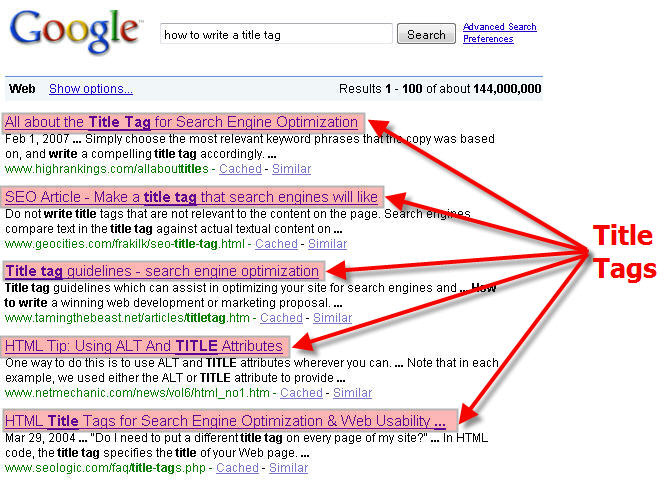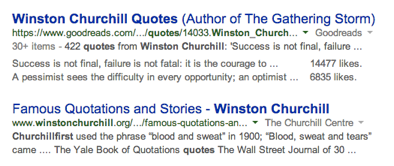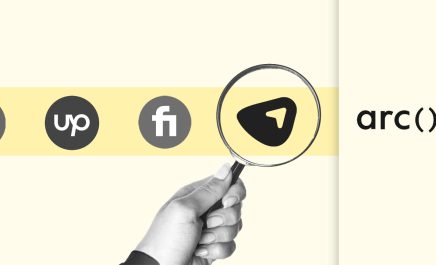7 Tips for a Perfect Title Tag
- Rahul Doshi
- June 18, 2014
- 4 Minute Read

There has been a tremendous amount of debate over the optimal length of a title tag. Historically the recommendation has been for the tag to be anywhere between 65 and 70 characters. It was never entirely understood what length Google was looking for before a cutoff, and now we know why. Google has recently redesigned their search engines appearance, and through vigorous testing it has now been verified that Google was never really measuring the number of characters, but rather the pixel width of the total title tag. The latest redesign leaves title tags at 10-15% shorter, with an average 55 character limit. So, lets see what we can do for title tag optimization with some good title tag examples.

Tip 1: Differentiate
Always keep in mind your title tags will be compared by the user to all your competitors title tags. This means going against the grain will typically generate strong results, since a positive outlier is likely to generate traffic above its ranking position. Remember that at the end of the day you are trying to generate a click from the user. This means the first 25 characters need to grab the users attention, and so having the keyword at the beginning of the title tag might not be the best title tag optimization approach.
Most title tag examples begin with the brand; if your competitors are doing this, try starting with something more conversational, or an offer of some kind.
Tip 2 – Bold is Better
The most powerful aspect of visibility is contrast, and this means bolded portions of title tags will immediately grab the users attention. Bolded words pull us in because the suggest importance, signal strength and differentiate ones title tags from competitors. Achieving bolded portions in title tags means anticipating search queries, so use frequently searched head terms for title tag optimization. This will increase both clickthrough rates and visibility.
Tip 3 – Theatrics Matter
As an experiment, search for “homes for sale” in Google. Notice how some of the results have to do with real estate? This has to do with with Google’s intelligence – it doesn’t just match user queries to website content, it also tries to guess what the user is really looking for, and so it learns over time that searches for “homes for sale” will be satisfied by “real estate” websites.
Keep this in mind when designing your title tags. You don’t have to be a slave to exact search queries, having theatrical and smooth title tags inside a specific vertical will appease Google all the same.
Tip 4 – Have a Call to Action
The goal of showing up in Google’s search engine is to inspire clicks from users. In the history of Advertising, it has always been understood that having a phrase to inspire users to a specific action works brilliantly. Call to actions can range from “click here” to “find out more”. A call to action is readily defined by an active verb – make sure you have one. Title tags are short, so room for creativity is limited. Meta tags with their greater length are better candidates for quixotic calls to action.
Tip 5 – Compensate!
The easiest way to generate traffic to your website is to maintain the first position. It is estimated that the first position of the page will capture half of all search traffic. But it isn’t always possible to maintain first position, so improvise! Google has a whole host of powerful tools beyond just the wordage of a tag, such as social hooks. Which of these two title tag examples would you click?
Always think creatively about how you can differentiate your Google listing relative to your competitors. You have to employ your creativity for title tag optimization.
Tip 6 – Go Dynamic
Whilst a much more advanced tactic, title tags can actually be dynamic. With the appropriate CMS, title tags can include data feeds of inventory, sales data, or anything else. This is very rarely utilized by the industry but it is unquestionably a powerful tool since numbers (and especially live numbers) are far more attractive to users than words. For smaller businesses this is probably out of reach – for larger ones, the sky is the limit.
Tip 7 – ABT, Always Be Testing
The power of white label digital marketing lies in its ability to be tested to infinity. Markets change over time, as does Google itself, so never sit content with what you have. Test your tags aggressively and don’t be afraid to change them. You need to in a continuous title tag optimization process. Track your organic traffic performance over time and adapt when performance seems to slow.
Always be testing!

Thank you for submitting the details!
We will keep your information safe. Feel free to contact us with any questions at hello@uplers.com
Please check your email for next steps shared by Robert.



![How to Hire an SEO Expert from India: Guide for Hiring Managers [+SEO Specialist Job Description Tips and Salary Analysis]](https://www.uplers.com/wp-content/uploads/2024/03/How-to-hire-an-SEO-expert-from-India-Guide-for-hiring-managers-Job-description-tips-and-salary-analysis-436x265.jpg)















